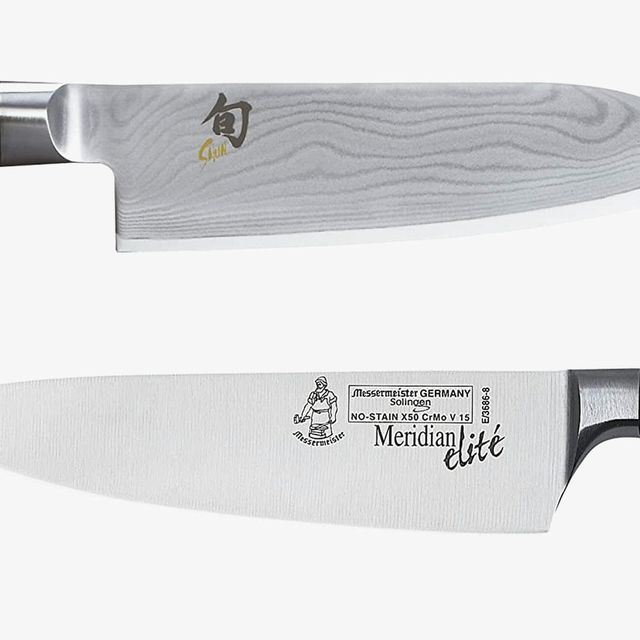Each kitchen knife serves a distinct purpose. Paring knives and boning knives are used to achieve very different ends, as are bread knives and steak knives. But beyond silhouette, the steel from which a knife is forged also shapes its intended use. Most kitchen knives fall into one of two categories: German- or Japanese-made. The difference between the two lies primarily in steel hardness and edge angle, which, in turn, ladder up to distinctions in durability and intended function. When it comes to kitchen knives, however, the more hard-wearing option isn’t necessarily the better choice.
Steel: Steel is an alloy composed of iron and carbon. The amount of carbon in a piece of steel directly correlates to hardness and inversely correlates to durability. Due to a difference in forging techniques, Japanese steel blades contain much more carbon than German blades, making them harder, but also more brittle. Because Western-style steel is relatively softer, it’s capable of holding an edge longer and doesn’t need to be sharpened quite as often as Japanese blades do.
Edge: Japanese knife blades are thinner than their German counterparts, allowing for a sharper edge — typically in the range of 15–16 degrees, compared to 20 degrees in Western-style knives. While German blades are typically finished with a machine, Japanese blades are almost always hand-honed and hand-refined. The edge of most Western-style blades is curved to allow for rocking cuts, while Japanese blades are straighter in order to facilitate clean, precise slices.
Construction: Most German knives have a full-tang construction, which means that a single piece of steel runs from blade to butt. Japanese blades taper inside the handle, making for a lighter, front-weighted knife to enable more controlled movements.
Function: Japanese kitchen knives are precision cutting tools, designed to slice first and foremost. German blades are more versatile, used for chopping, cutting and slicing; their multi-purpose nature and increased durability go hand-in-hand.
German Kitchen Knives
With a bolster for a controlled, comfortable grip and full tang construction, Western-style chef’s knives are weighty and durable. While most blade faces are flat, those with ridges (like the Wüsthof one pictured here) are designed to keep food from sticking to the knife while chopping.
Three to Consider (From Left to Right)
Zwilling Professional “S” Chef’s Knife ($150): Zwilling is a leading German knife manufacturer. Its Professional “S” knife is made from a single piece of solid steel with an ice-hardened Friodur blade. The product details say you can safely throw this in the dishwasher, but please don’t.
Messermeister Meridian Elite Chef’s Knife ($120): Handcrafted in Solingen, Germany, this Messermeister knife is made of German 1.4116 high-carbon, stainless alloy, which is razor sharp and resistant to stains and corrosion. A knifesmith hammer forges the knife so the blade is strong from heel to tip.
Wusthof Grand Prix II Cook’s Knife ($150): Wusthof’s modern forged series of knives are precision-forged from a single piece of high-carbon stainless steel. The pebble-textured handle provides a comfortable grip during long prep sessions or quick cuts.
Japanese Kitchen Knives
Gyuto and Santoku are the least specialized (read: most general-purpose) styles in the Japanese knife arsenal. Though they most closely resemble Western-style chef’s knives — with wide, wedge-like silhouettes that expand their utility — they have thinner blades, harder steels and sharper edges than their Western counterparts, allowing for more precise cutting.
Three to Consider (From Left to Right)
Akira-Saku Blue #2 Funayuki Gyutou ($120): The carbon steel is graded White Steel #1, which means has more carbon than a carbon steel of grade White Steel #2. The added carbon makes for a blade that’s harder and can therefore be sharpened to a finer edge. The knife is finished with an octagonal handle that is comfortable to hold.
Shun DM0702 Classic Santoku Knife ($110): This Shun santoku knife is clad with 16 layers of stainless steel for a sleek Damascus pattern. And the blade works as well as it looks. The precision-forged high-carbon, stainless-steel blade stays razor sharp for an impressive number of cuts.
Korin Special Inox Black Handle Gyuto ($288): Korin’s knife master, Chiharu Sugai and Knife System Company’s founder, Junro Aoki, teamed up to make this impressive gyuto knife for expert chefs. The AUS-10 steel has higher carbon content sans maintenance associated with carbon blades. The knife is the epitome of Japanese craftsmanship and generations of knife expertise.


















